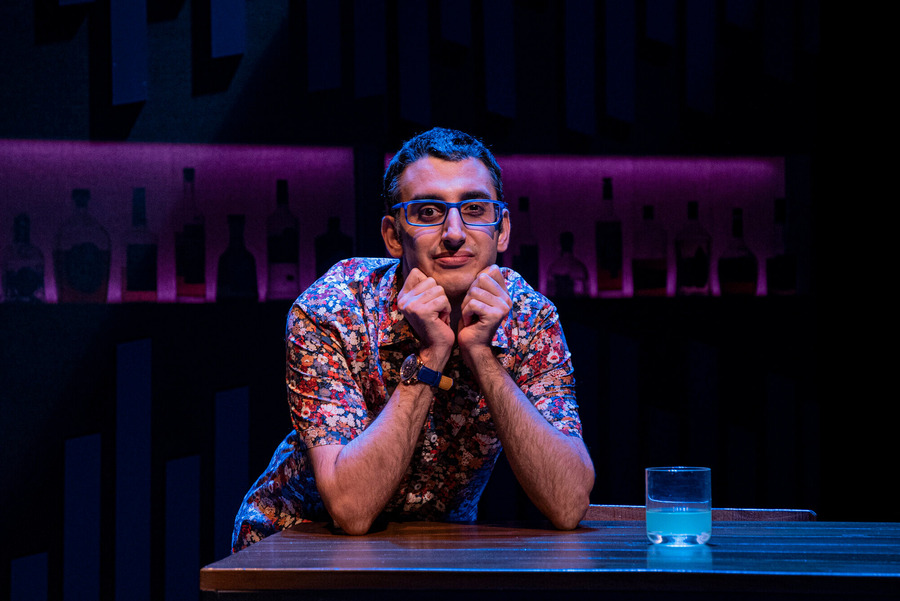You may recognize Ryan J. Haddad from one of his roles on television, such as his recurring role on Netflix’s The Politician. You might have seen a performance of his acclaimed solo play Hi, Are You Single? at Woolly Mammoth last spring, or at the Public’s Under the Radar Festival back in 2017. Maybe you were even lucky enough to meet him at a bar or match with him on Grindr.
However you have come to know Ryan, one thing about him is abundantly clear: He’s got a big personality. He takes inspiration from similarly gargantuan personalities: Oprah, Lucy, Whoopi, Rosie, Patti, Whitney, Brandy, to name a few. Someday Ryan may join this first-name-basis group. Until then, he just hopes we can keep up.
Haddad is no stranger to American Theatre‘s pages, but this is his first time being interviewed by me—a fact that’s largely insignificant, except for the fact that I, like him, have cerebral palsy. Needless to say, I seized upon the opportunity to meet an icon, and he didn’t disappoint.
The occasion for our conversation is his Off-Broadway debut as a performer and playwright at the Public Theater later this month with the audaciously autobiographical Dark Disabled Stories, which runs at the Shiva Theater Feb. 28-March 26. The promotional material describes it as “a series of unforgiving vignettes about the strangers he encounters while navigating a city (and a world) not built for his walker and cerebral palsy.” But the play is so much more than that. This time Haddad is ripping off the band-aid and bleeding for the sake of the story. Produced by the Bushwick Starr and directed by Jordan Fein, Dark Disabled Stories deals with implicit ableism, yes, but also the narratives we project onto other people, as well as ourselves.
I spoke with Haddad on Zoom last week, then had the privilege to sit in on a rehearsal for Dark Disabled Stories. Fein’s production cleverly incorporates American Sign Language (ASL) and audio description into the design, with delightful results. As Haddad plays versions of himself at various points in his life, Dickie Hearts’ performance as Ryan in ASL and Alejandra Ospina’s audio descriptions add layers of hilarity. Watching them all play off of each other is such a treat, and I was able to glean so much from their rehearsal process. (If you don’t already know the signs for “blowjob” or “asshole,” you just might learn a thing or two.)
In our wide-ranging conversation, Ryan and I talked about influences, assumptions, hopes, and our shared affection for Raúl Esparza.
ALEXANDRA PIERSON: How did you get started in theatre?
RYAN J. HADDAD: It really did start with me consuming what was sometimes age-appropriate material and sometimes not. So Disney movies: Snow White, Cinderella, Sleeping Beauty. I loved those three princesses more than anything. Also Sister Act 2, The Nanny, The Golden Girls, and I Love Lucy. What is the common thread of all of that? Women, fabulous women who are at the center of these stories. I just connected to these stories as this little boy who was a budding homosexual, though I certainly didn’t know and my family didn’t know. I was just absorbing it all, and then my outlet would be to imitate, to act it out. I would crawl around the living room. I was maybe starting to use the walker then, but before the walker, my mobility was crawling or going on two knees. I would just do these one-person events of these pieces of culture. It would come together through the TV screen, and then I would act it out myself. Then I got my family to join me. And we did the Haddad Theatre for eight years, and we put on plays together in the backyard, in the living room, in the basement, and then ultimately on the stage of the community center.
Woven into all of that was my parents recognizing that this was my passion, and then also recognizing that the family could not be my teachers forever. I remember this moment with my mom when I was about 7; I think we were in her bedroom, and she had found an ad in the classifieds for acting classes, and that was when she signed me up for my first acting class.
When did you start putting pen to paper, wanting to tell your own stories?
I always kind of had that inclination, I think, but I didn’t know as a kid that it was a legitimate genre that could be written. I would always love the one time a year, in elementary, middle, high school, where we had to write a personal narrative essay, because I was great at that. And in conjunction or not with the Haddad Theatre was also the Ryan Haddad Monthly and Ryan Haddad Quarterly, which was my attempt to be Oprah and have an Oprah magazine. The logo was my signature to mirror Oprah’s signature on her TV show. I thought, “I’m going to act and I’m going to write.” So what does that mean? As a kid, I was like, it means I’m a theatre critic. That’s the easiest connector of those two things. It was never, “I’m a playwright.” So I was trying to pretend I was passionate about journalism and make this newsletter, which lasted for six years and changed forms halfway through from monthly to quarterly, because a) I ran out of steam to do it every month, and b) the quarterly issue was even bigger. Everyone in the family and extended family would pay $1 a month, and we would send it to them. I look back now and I’m like, well, from the stamps, to the paper, and the ink costs, my parents were fully losing money on this hobby of mine—and then I would take everybody’s dollar-a-month and go put it in my piggy bank.
That was when I started flexing my writing muscle. I wasn’t writing necessarily about me, and I certainly wasn’t putting any of it on the stage that was directly about myself. That didn’t come until college. I was at a liberal arts school in Ohio called Ohio Wesleyan University, and simultaneously I was doing personal essays in the English department, which was the first time I really learned that personal essay was a genre that people actually read and submitted to Best American Essays. That was half of Nora Ephron’s career, and I love Nora Ephron but I knew her from the romantic comedy movies, not from her personal essays. So then I started reading all of those and doing all of that, and I was taking playwriting classes in the theatre department as well, badly faking that these plays weren’t about me, and changing names and characteristics, but everybody knew immediately—it’s Ryan.
Finally my mentor in solo performance, Tim Miller, came in as a guest artist during my sophomore year of college. He saw the bones or the substance of everything that I was doing in all these different places and forms and mediums, and was the one to make them all coalesce, and say, “You know, you could actually do personal essay onstage. You don’t have to wait for somebody to give you a part—you certainly don’t have to wait for one of these professors, who don’t know what to do with you or your walker, to give you a part. You can make your own part. In fact, that part can be a character named Ryan, and you can play him, and it is a legitimate form of performance.”
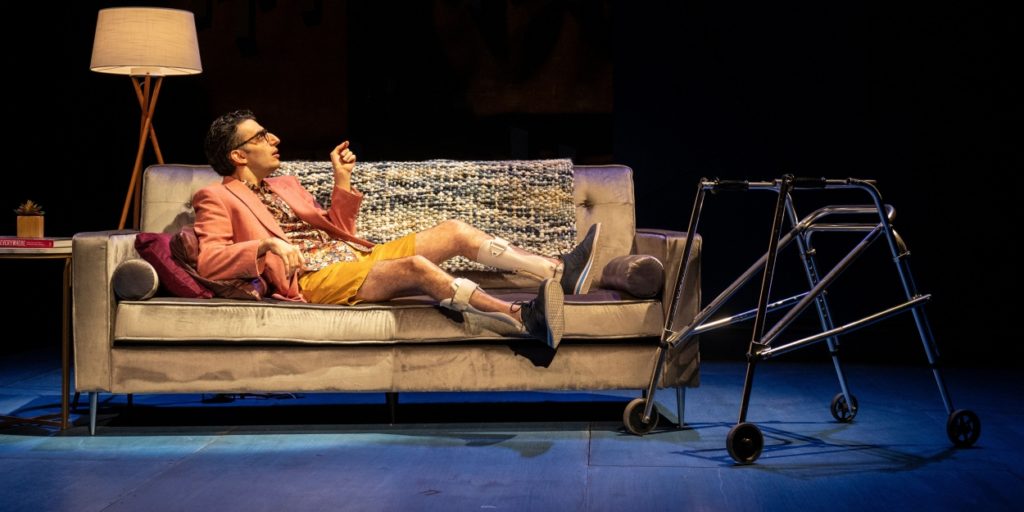
It’s what Tim had been doing for 30 years. It’s what his peers and colleagues in New York, Los Angeles, and across the world have been doing. I just had no idea. the only people that I saw get up and do solo performances were celebrities; It would be one person playing Virginia Woolf, or Bette Midler playing Sue Mengers in a play on Broadway. Okay, fabulous. But I knew I wasn’t that, and I wasn’t putting on a character. So Tim really just gave me the permission to start doing what I do now, which is personal storytelling as theatre.
How did it feel to realize that, like Oprah or Lucy, you could be the show—that you were enough and that people would turn out for you?
I think, as a kid, whether it was from ego, or stubbornness, or pompousness or whatever, I was like, “I’m a star, I’m a star, I’m gonna be a star.” I was dreaming of red carpets, flashbulbs, all that stuff, but it also meant like, “I’m the center of a story, of a work.” And then all through my childhood, adolescence, and even into college, it was like, “Why doesn’t everyone else know that? Why doesn’t everybody else see that I have the actual energy, charisma, persona, the channeling of someone that is unique?”
I’m not saying “special” in a disability sense, but as a combination of all of these elements that make someone into a star, and I’m not saying to you now that I’m a star. I’m a working actor and a working playwright. When I’m onstage in one of my works for an hour or 75 minutes, I’m a star—I’m the star. I’ve been saying that to people in the press since 2015, so I don’t think it is a pompous thing to say. What it means is the lights are turning on me, and here it is, this is my story, and you’re paying attention.
Tim’s permission to tell my own stories, and the idea that being Ryan was enough, was thrilling. I had gravitated so strongly toward these leading women; I had grown up watching and wanting to be, not only an artist, but also a personality, to be able to take up space, and to be able to be at the center. From the time of doing the Haddad Theatre in the backyard, I knew I belonged at the center. Then I was told through time—in youth, adolescence, and puberty—that maybe the boy with a disability is not meant to be at the center. The world was telling me, actually, no, I belonged as the sidekick, off to the side, or somebody’s father or grandfather, somebody’s uncle. I can’t wait to play those roles again when I’m in my 60s and 70s, but I knew that I needed a vehicle not only for the kind of stories I wanted to tell, but also the kind of performer I wanted to be, and the kind of performances I wanted to be giving.
No matter what direction my career takes, whether it’s more theatre, film, TV, or a combination, and no matter what projects I expand out from and keep going toward, I still think I’m going to keep coming back to autobiography. And as long as I keep living life, I really don’t think I’m going to run out of stories or run out of the desire to be the one telling my stories.
This time around, though, Ryan isn’t the only one telling stories.
In this show there are other actors, who I need to acknowledge before you sort of run away with the “I’m a star” paragraph. You have two performers in this play with me, Dickie Hearts and Alejandra Ospina. Dickie is playing “me” simultaneously with me, and he’s giving a full performance as Ryan in American Sign Language, and we’re really interacting with each other. Our staging is very dependent on one another and our energies are feeding off of one another. So in this case, there are two Ryans on the stage. The stories of Ryan are still “the star” as it were, but there are two Ryans that you can sort of choose between.
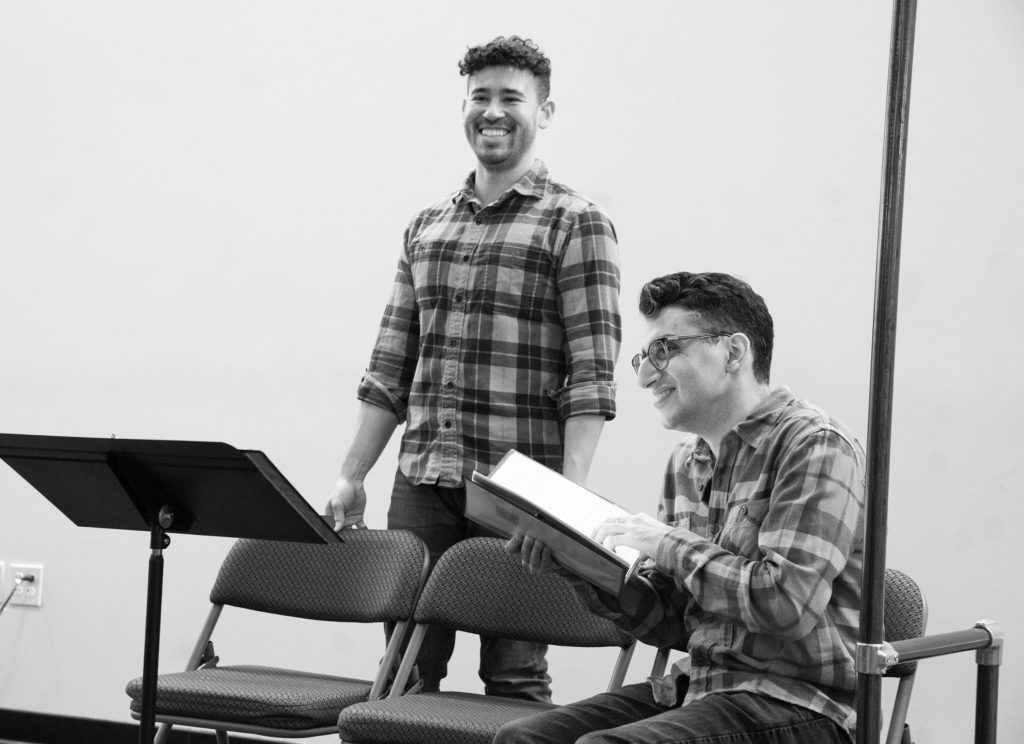
We are very aware that for the d/Deaf people in the audience, their Ryan is going to be Dickie the whole time. That’s so exciting. Dickie is a star. Dickie came into our workshop, and it was like, [gasps] “Who is this fabulous presence, who is so funny, and so unapologetically himself, and who is a fabulous queer man who is not afraid of his fabulosity?” I thought, who better to take on these stories than someone like Dickie? It’s a great trust I’m experiencing for the first time to be able to watch someone else play me, while I’m also still there, still playing me, giving my own performance, which is sometimes close to Dickie’s and sometimes not. It’s really thrilling.
And then Alejandra is providing our audio description, which is so very much a part of the text, and we’re discovering it in rehearsal. As we stage something, we then go back and say, “Now that we’ve staged it, how are we going to describe what we’ve staged, and what are the visuals that are invoked here, so that blind and low-vision people can access the play just as much as the d/Deaf and hard-of-hearing people?” Both of them individually will tell their own stories at different moments in the show, where they will sort of step out of their support of Ryan’s stories. They will have their own moments from their own points of view as Alejandra and Dickie.
Were ASL and audio descriptions included in the script from the beginning?
No, they weren’t. This is a set of stories I’ve been developing since 2017, and collaborating with my director, Jordan Fein, who is not disabled but is a fabulous queer man who has really taken it upon himself to develop a rigorous education in disability aesthetics. When we started collaborating together, it was just going to be a solo piece. But over those years, from 2017-19, I was becoming more immersed in disability arts across genres. I started to see work by my now dear friend, Alice Sheppard, and her collaborator Laurel Lawson, of Kinetic Light, also work by Jerron Herman and Molly Joyce. Alice and Laurel have access doulas, they have captions, they have multiple types of audio description that you can choose from as you’re sitting in your seat and decide, how do I want this dance to be interpreted? Do I want it to be interpreted in a straightforward way or in a poetic way? What are the ways in which almost all people can come in, because no access is perfect?
We all recognize that in this production or any production, in any space that attempts radical access, no one is going to get a perfect score. There might always be someone who comes in and needs something that you didn’t account for or didn’t plan for. Our performances will also be semi-relaxed, which I have not done as a performer before. I’m excited for it, I’m intrigued by it, and I hope that I have the tools that it takes to be able to hold a room with that kind of care and that kind of flexibility. We’re still figuring out what exactly relaxed means for our specific production.
And we had been chewing, Jordan and I, on the idea of what the play should look like. And then we had a pandemic, which meant that we couldn’t do the play in the spring of ’21, when it was originally slated for the Bushwick Starr, and we had a lot of time. So Jordan and I just sat on Zoom together every week for two hours, and together we arrived at the idea of, what if the design is the access and the access is the design? I want to be very clear that this is not a new or revolutionary idea. It has been happening in disability spaces for decades. What is new is bringing it to Off-Broadway theatre at a place like the Public.
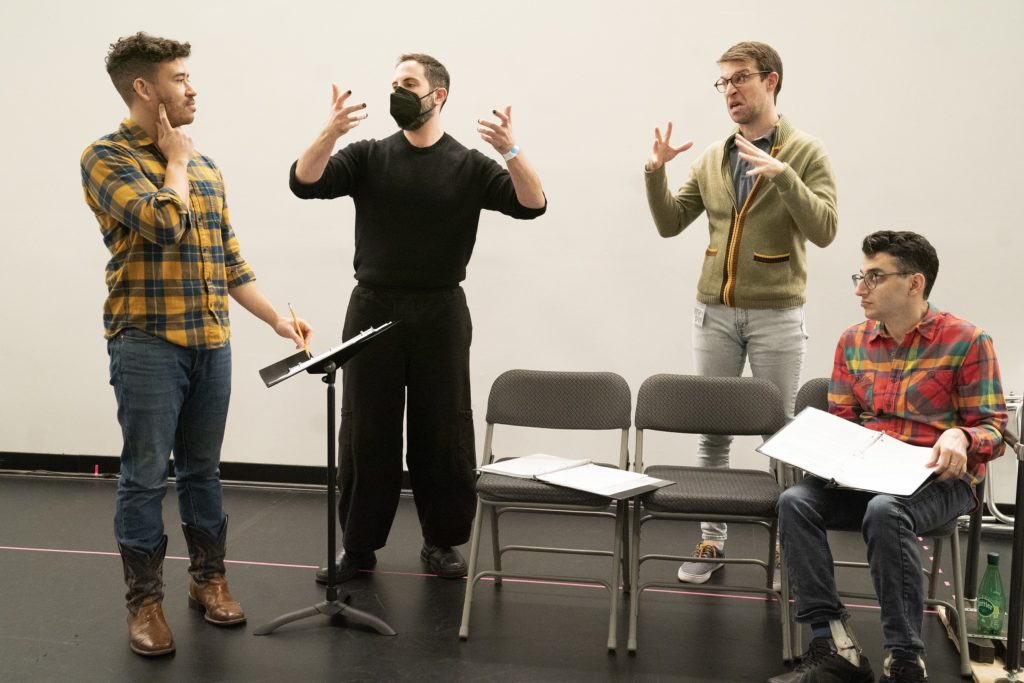
I cannot promise that all of my plays going forward will be written with this degree of access written in, especially those I had written prior to writing Dark Disabled Stories. It’s hard to go back and retroactively do it all at once. I’m saying that to protect myself from ridicule, if the next time there’s not all of this at every single performance. If you go to see Kinetic Light, they have multi-channel access, where you can make those choices—whether you need the captions, the audio description, which kind of audio description you would prefer, whether you are a person who needs all of these things. And in many ways, that is a preferred method, the ability to have choice. We’re not quite doing that here, where everything is open channel. Everything can be seen and heard by everyone, of course, knowing that those terms “seen” and “heard” are specific to those who have access to those modalities of communication. But this is an experiment in many ways. There are going to be things that we trip on, and there are going to be things that are imperfect.
Is the total package that we’re offering going to work brilliantly for every single person who walks in, disabled or not? I’m not sure, but we’re trying it and we’re making this offering and this invitation to disabled audiences to say, you don’t have to pick which one performance of the run you can access, you are able to access them all. You can come at any time and we want you there, you have the invitation to the theatre, which is a place, even with the best of intentions, that I think we’re not always invited to as audience members. Even when the play has been about disability in the past, my own work included, that kind of blanket invitation has not always been there for different kinds of communities and different folks within the umbrella term of disability, which is not one-size-fits-all by any means.
What does the “dark” in your title mean to you?
Dark means that humor is not used as a defense mechanism or layer of protection, which I employ in almost all of my other work, and I also sometimes employ in this show, even though I say I’m not going to. It is a funny show, and there is dark humor; there is just plain humor as well. I need you to be able to laugh with me, but in this play, laughter is not used as much as a tool for the character of Ryan to navigate these stories and encounters and interactions, and is also not used as a guide for the audience either. There will be laughter, there will be humor, but it is not an easy ride. It’s certainly not a show full of trauma, pain, and pity. I’m not interested in that either, but I think a reason that disabled artists, myself included, use humor is to cut against those tropes or those stereotypes of how our stories are seen by other people. Humor is used as evidence of strength and empowerment and all of these things.
I just want to say one more time that the show is funny. There are lots of funny moments in this show, but the humor is not a band-aid this time.
So much of this play deals with narratives that other people project onto disabled bodies, their own perceptions and misconceptions about disability. Was this kind of “othering” lens an intentional frame for these stories?
I think it happened naturally. I certainly don’t want to make an audience feel like they’re ignorant. That’s not a good feeling inside of an audience. I don’t want them to be defensive either. But I also want them to hold themselves accountable and recognize, what are the narratives that you have put on me by just coming into this space, and seeing what you think this show is going to be about? What are the assumptions? This is a play about assumption, it’s about perception, and it’s about the projection of a narrative that I have no control over. The non-disabled version of that projection is based on what people have been fed by the media, and their limited access to disability in their own lives. Sometimes even when they have close access to disability in their own lives, they’re not viewing that friend or loved one as an empowered individual. They’re not viewing the totality of the human being, they’re just seeing the disability.
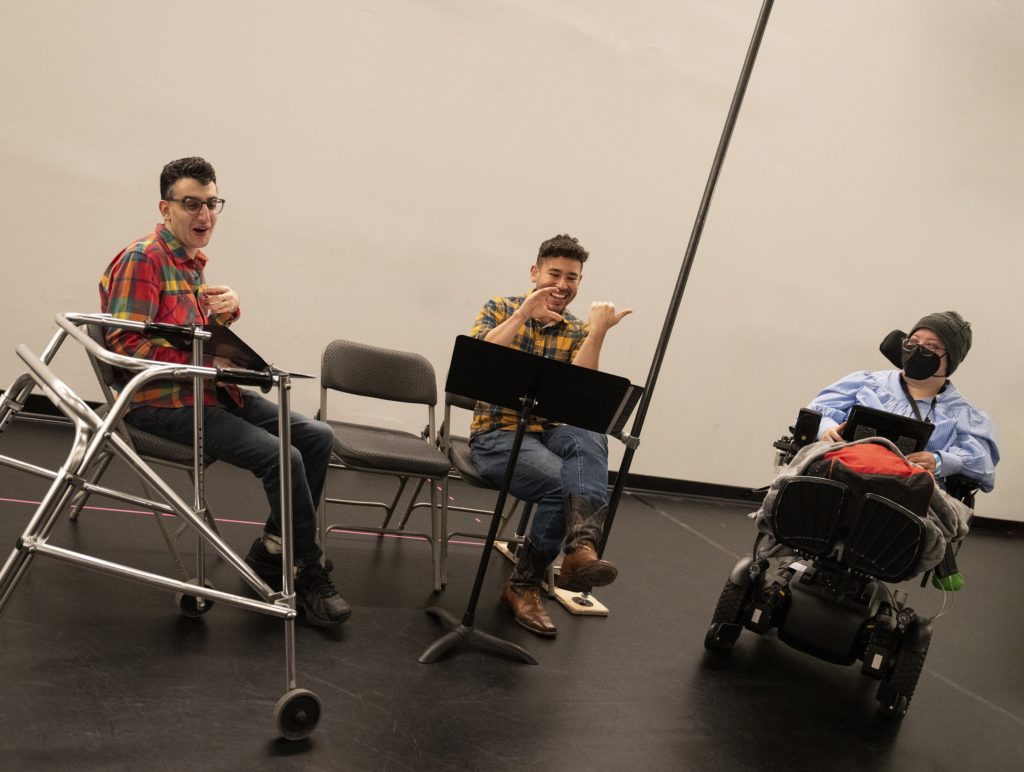
I was invited to perform at a festival called American As Fuck, or AmericanAF, that Jess Almasy was curating. It was at the New Ohio Theatre in the fall of 2017. I just knew, based on the roster of artists that were involved and invited, and the sort of depths of the work that they were probing inside of this festival, that I couldn’t just take a piece of Hi, Are You Single? and put it in this festival; the tone was just so different. So I put a couple bullet points on a Post-It note, and very organically, in the way that Tim Miller taught me, just told stories. Many of them had happened very recently. A lot of these stories are from late summer and fall of 2017, but I just picked an arbitrary order and put them together. I didn’t know yet that it was a play. I didn’t know that it was going to be the next big work of mine that I was going to spend years and years developing, so the commonalities and the overall themes were not so clear.
God, it is relentless what disabled people are meant to experience by just entering society every day. That was all I knew then—that these were things that had happened that didn’t make me feel very good. I didn’t quite know why they all happened, why they were happening to me, or why they had happened in such quick succession. I wasn’t tracing what this play was about. I just knew I had these stories to tell; let me get them out into the world. I never recorded that night. That was a great mistake, and I’ll never do that again. I know now to always record because that is how I draft these new pieces, these new works.
So because I didn’t record it at AmericanAF, having been given that platform to really birth these stories for the first time, I went to another wonderful writer, performer, actor, entertainer Drae Campbell, who hosts a monthly storytelling show called Tell at the BGSQD, the Bureau of General Services—Queer Division, inside the LGBT Center. And I said, I’ve got to do these again, and this time, we’re going to record it. It was a 40-minute recording, and that recording provided the bones and skeleton for the script. But even then, what’s the order? We went through so many different opening stories. We’re still figuring that out in the middle of rehearsal. We sort of know what the order is now, and we’re really certain on what the last story is.
Part of it being an ongoing discovery for us is that we can’t dictate what the audience thinks. We can try our best to ask what we want the audience to walk away with, what should that final note be, that final gesture. But we can’t really control how it’s going to be interpreted, and what disabled people are going to take away versus what non-disabled people are going to take away from it. That’s exciting. It’s also a little scary, because I don’t want, particularly non-disabled audiences to walk away feeling pity, feeling trauma and gloom, and thinking, “Wasn’t that sad because they’re disabled?”
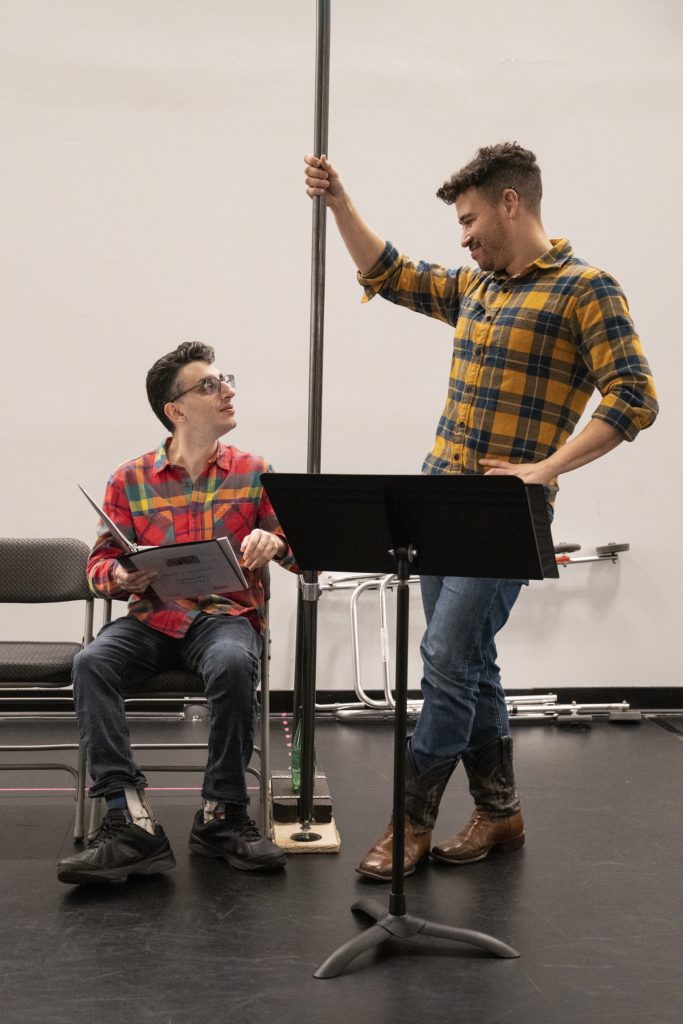
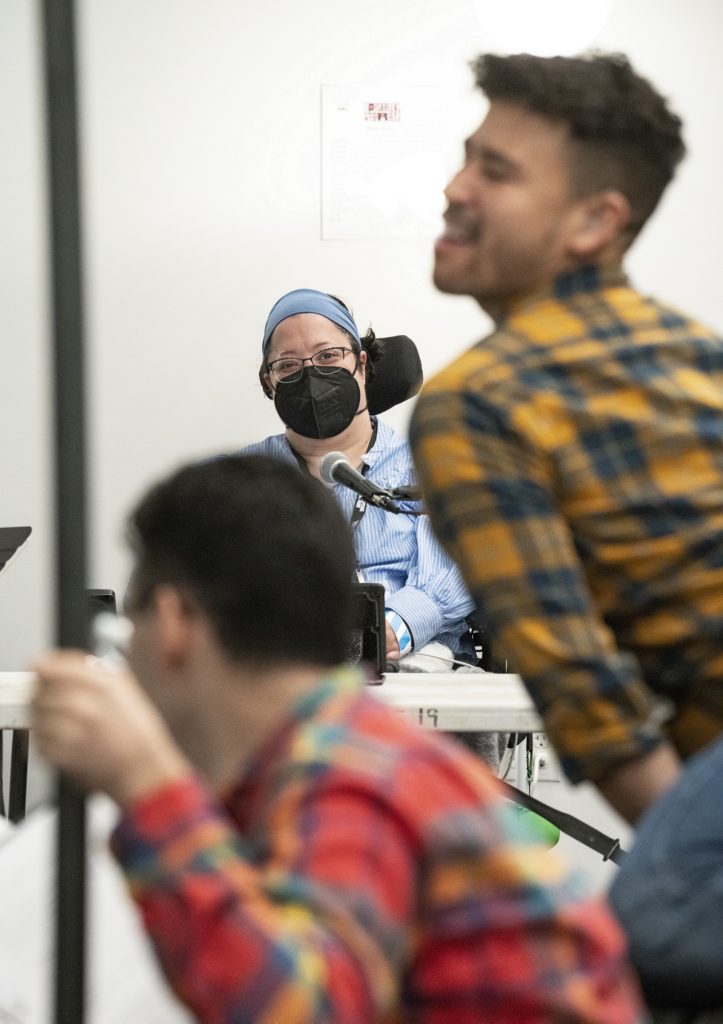
The show is difficult, and gritty, and honest, with moments of sadness, shock, gasp, all those things. But it isn’t because we’re disabled; it’s because of the way the world treats us as a result of being disabled. The disability is part of our identities, it’s part of who we are. The cumulative effect of the stories should be asking, what is wrong with the world and the way that the world puts us in boxes, and treats us like we are less than? We are not. The last thing I want is for someone to walk away thinking that we are less than just because these stories aren’t knee-slapping funny.
There’s a moment early on in the play where your character tells the audience, “Not everything is accessible to us, so why should we try to make our experiences accessible to you?” Was that an obvious conclusion that you came to in your own life? Do you feel like maybe you are accustomed to over-explaining, or feel a certain pressure to explain yourself in order to be understood?
It wasn’t obvious. In those two improvisational tellings in the fall and winter of 2017, I said that, or something like it, to push myself off the cliff and say, “Remember, Ryan, you promised them that you weren’t going to take care of them with the tone. These stories are going to be for you, and these stories are going to be for your disabled peers, colleagues, friends, fans.” It was a charge to myself to not lean back on what is easy in disability stories, that kind of cater to the non-disabled lens. I’m not saying there are no elements of this show that do that—there are, and there are plenty of moments in the play where we’re talking about my needs, these are my needs, this is how I operate in space—but it’s there in protest of an other, an outside force, assuming that they know what isn’t and isn’t best for me. It’s in conflict with the world that I’m sort of railing at those things.
But it’s not easy. It’s something I’m being very careful of in this play. I recognize that my other work is just a little softer, a little gentler, so that I can sort of hold your hand and say, “Now, I know you don’t know everything I’ve experienced, but it’s okay, you’re gonna relate to this too, I promise.” I still think that’s true in Dark Disabled Stories, but without the handholding—without the gentleness of that invitation explicitly for non-disabled people. I’ve trimmed the excess to make it as close to what my day-to-day is like, where there’s no warning of when your disability is sort of shoved back in your face. There’s no preparation for that.
There’s a scene where your character describes having a fall, and it’s one of those life moments where your disability is just shoved in your face. In that moment, your character decides what his needs are, and whether he, as a person, is okay. The reality is that as folks with CP, we’re gonna fall from time to time and it’s gonna hurt, and it’s gonna be a pain in the butt. How do you begin to accept the fact that sometimes you’re going to fall?
I don’t fall onstage. We don’t literally see it happen. But I fall, occasionally, sometimes more and sometimes less. I have cerebral palsy; that has always been the truth of my whole life. I’m used to it in many ways. I have protected myself, I’ve learned how to fall in order to protect my head, protect my face, but it’s gonna take its toll on my elbows, I just know it, because I always land forward on my elbows. That doesn’t take away any of the surprise of it when it happens. You’re never planning to fall, it just happens. And It’s not fun. But it’s something that happens regularly. And so I just have to dust off and say I’m okay.
As I get older, I have fear and worry that, once in a while, it may not be so okay. What is it like for me to fall and get back up here in my apartment, versus what is it like to be out in the street on the sidewalk where there’s nothing to really brace myself on? It’s not as comfortable, and sometimes the concrete causes bleeding. What’s it going to be like when I get older? This is true of aging across the board when you’re in your 60s, 70s, or 80s.
As my parents get older, as loved ones around me, aunts and uncles, age, I’ve spent a lot of time thinking about what that means for myself. Knowing that my cerebral palsy is not degenerative, that I will not decline as a result of my cerebral palsy, but that I’m still going to age the way that others age, and with age comes some kind of new reality—wondering what is the tango going to be between the cerebral palsy and the aging is something that scares me a little bit. It is something that I know I will face as it comes. There will be change over time—that’s true of everyone, disabled or not—but I think that having cerebral palsy makes me brace for that change earlier than others might have to.
What’s next for you?
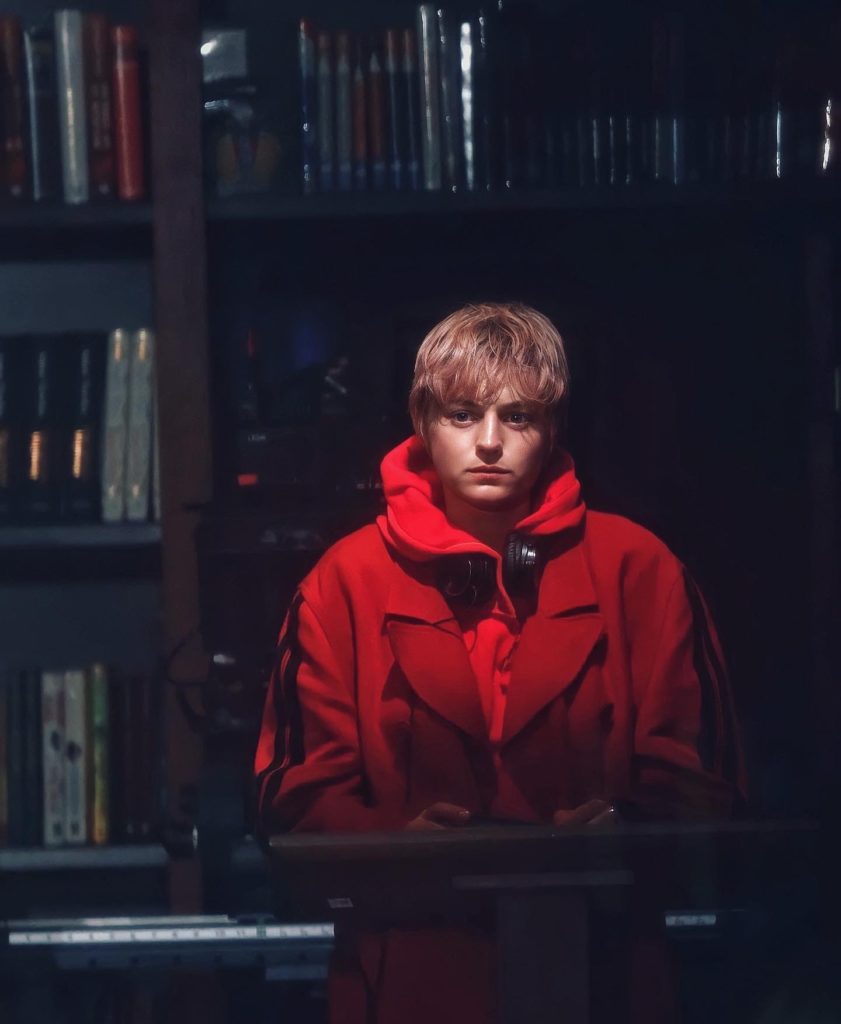
I don’t know when it’s going to come out, but there’s an FX limited series called Retreat, it stars Emma Corrin, Brit Marling, Clive Owen, and Raúl Esparza—which for me as a theatre kid was like, oh my God. From the first moment, I just came right up to him, and I said, “I lived and breathed your live recording of Company.” And he’s such a sweetheart. He took on this mentor role. I just had to pinch myself.
In the midst of that, I’m still championing strongly that Hi, Are You Single? make its way to Off-Broadway. We’re sort of working out possible in-betweens elsewhere in other cities, potentially before New York. There is a sequel to Hi, Are You Single? called Hold Me in the Water, which I’m dreaming will happen in repertory so that you see one version of Ryan one night and a different version of Ryan the next, because I think those plays really do speak to each other and have exciting threads of connection.
Also there’s my first true multi-character play, Good Time Charlie, about my family, in which my gay Uncle Charlie is the star and I’m the supporting second banana, as it were. It has my parents, it has my aunts and uncles, and it has my friends. It’s very queer and very campy, and has a lot of heart. I love having the ability to to play literal scenes from my life onstage with someone as my mom and someone as my dad and someone as my gay Uncle Charlie, and getting to tell a story of dreams, hope, and ambition, and also dreams deferred and other paths taken. It’s a multigenerational story. We just did a workshop last fall, so I was actually standing up playing scenes with characters of my family, and then sending the real people pictures and saying, “Look at them, they’re you! Isn’t it wonderful?” That play is very close to my heart. I’m hoping that it might be the thing that happens next.
Alexandra Pierson (she/her) is associate editor of American Theatre. apierson@tcg.org

